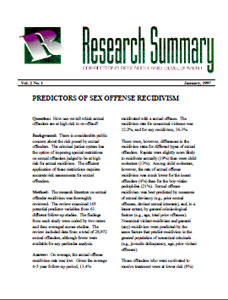Predictors of sex offence recidivism
Research summary
Vol. 2 No. 1
January 1997
Question
How can we tell which sexual offenders are at high risk to re-offend?
Background
There is considerable public concern about the risk posed by sexual offenders. The criminal justice system has the option of imposing special restrictions on sexual offenders judged to be at high risk for sexual recidivism. The efficient application of these restrictions requires accurate risk assessments for sexual offenders.
Method
The research literature on sexual offender recidivism was thoroughly reviewed. The review examined 165 potential predictor variables from 61 different follow-up studies. The findings from each study were coded by two raters and then averaged across studies. The review included data from a total of 28,972 sexual offenders, although fewer were available for any particular analysis.
Answer
On average, the sexual offense recidivism rate was low. Given the average 4-5 year follow-up period, 13.4% recidivated with a sexual offense. The recidivism rate for nonsexual violence was 12.2%, and for any recidivism, 36.3%.
There were, however, differences in the recidivism rates for different types of sexual offenders. Rapists were slightly more likely to recidivate sexually (19%) than were child molesters (13%). Among child molesters, however, the rate of sexual offense recidivism was much lower for the incest offenders (4%) than for the boy-victim pedophiles (21%). Sexual offense recidivism was best predicted by measures of sexual deviancy (e.g., prior sexual offenses, deviant sexual interests), and, to a lesser extent, by general criminological factors (e.g., age, total prior offenses). Nonsexual violent recidivism and general (any) recidivism were predicted by the same factors that predict recidivism in the general population of nonsexual criminals (e.g., juvenile delinquency, age, prior violent offenses).
Those offenders who were motivated to receive treatment were at lower risk (8%) than unmotivated offenders or those who failed to complete treatment programs (22%).
No single factor was sufficiently related to recidivism, however, to justify its use in isolation. The most accurate risk assessments were those that considered a combination of risk factors.
Policy implications
- The risk for sexual recidivism and non-sexual recidivism should be considered separately. Different factors predict different types of recidivism, although certain offenders may be at high risk for both types.
- A range of risk factors need to be considered when determining an offender's risk for sexual recidivism. Most sexual offenders are never reconvicted for another sexual offense, but it is possible to identify a subgroup of high risk offenders.
- Although established recidivism risk scales predict general recidivism among sexual offenders, further research is required to construct risk predictions scales that specifically predict sexual offense recidivism.
- Specialized treatment programs can contribute to the identification and management of sexual offender recidivism risk.
Source
- Hanson, R. K., & Bussière, M. T. (1996). Predictors of sexual offender recidivism: A meta-analysis. (User Report No. 1996-04). Ottawa: Department of the Solicitor General of Canada.
For further information
James Bonta, Ph.D.
Solicitor General Canada
340 Laurier Avenue West
Ottawa, Ontario
K1A 0P8
Tel (613) 991-2831
Fax (613) 990-8295
e-mail jim.bonta@ps-sp.gc.ca
- Date modified:
